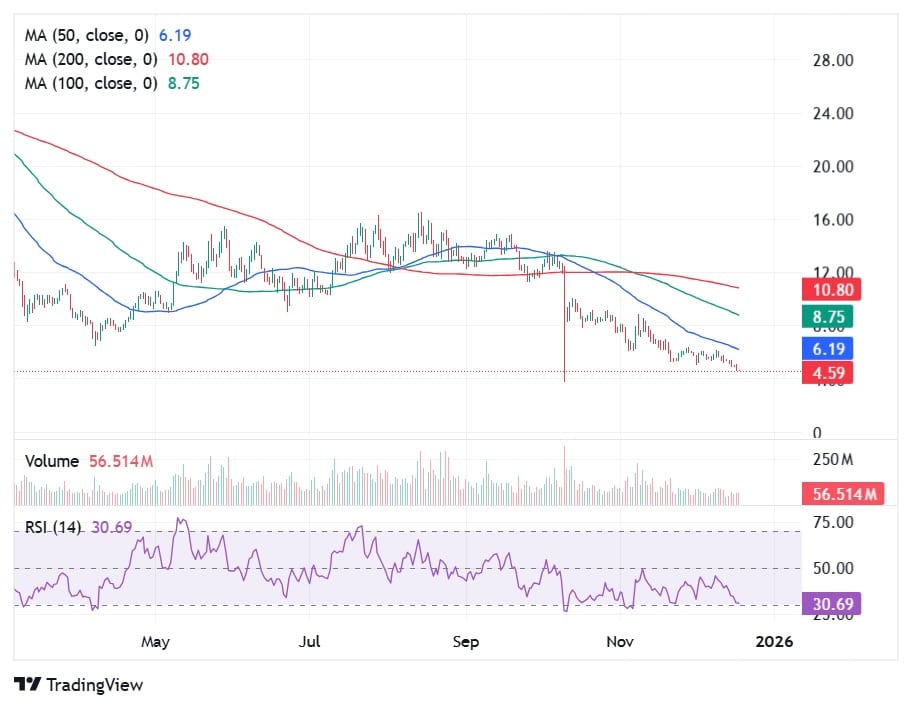How Solana's InfiniSVM and sBridge Are Redefining Real-Time Asset Mobility and Scalability for DeFi
- Solana's sBridge and InfiniSVM redefine DeFi with SVM-native cross-chain efficiency and hardware-driven scalability. - sBridge enables sub-second, low-cost transfers between SVM chains, outperforming EVM-based bridges. - InfiniSVM targets 1M TPS via FPGA hardware, aiming to support real-time DeFi applications and institutional use. - Solayer's tokenomics and partnerships aim to drive adoption, though short-term volatility and competition pose risks.
In the rapidly evolving world of decentralized finance (DeFi), cross-chain liquidity infrastructure has become a critical battleground for innovation. Solana's ecosystem, already renowned for its high-speed transactions, is now pushing boundaries with two groundbreaking projects: InfiniSVM and sBridge. These technologies are not just incremental upgrades—they represent a paradigm shift in how real-time asset mobility and scalability are achieved in DeFi. For investors, understanding their implications could unlock opportunities in a market poised for exponential growth.
The sBridge Revolution: Native SVM Cross-Chain Efficiency
At the heart of Solana's cross-chain strategy is sBridge, a high-performance bridge designed to eliminate the friction of transferring assets between Solana and other SVM-based chains. Unlike traditional bridges that rely on Ethereum Virtual Machine (EVM) intermediaries or centralized validators, sBridge operates natively within Solana's architecture. This design leverages Program Derived Accounts (PDAs) and hardware-backed ED25519 signatures to ensure tamper-proof, trustless transfers.
The results? Sub-one-second finality, a transaction fee of 0.0006 SOL, and a throughput of 1,000 transactions per second (TPS). These metrics outperform most existing bridges, making sBridge a scalable solution for SVM-focused developers and users. For context, consider the limitations of EVM-based bridges like Wormhole or Multichain, which often face bottlenecks due to Ethereum's gas constraints. sBridge's SVM-native approach bypasses these issues entirely, enabling seamless liquidity flows.
A would visually reinforce the bridge's role as a backbone for DeFi's next phase.
InfiniSVM: The Hardware-Accelerated Future of DeFi
While sBridge addresses cross-chain liquidity, InfiniSVM tackles the scalability challenges of DeFi itself. This hardware-accelerated layer-1 blockchain, developed by Solayer, aims to achieve 1 million TPS using FPGA chips and pessimistic concurrency control. The Devnet, launched in May 2025, already hit 250,000 TPS, with the mainnet expected in Q4 2025.
The significance of this cannot be overstated. Traditional blockchains like Ethereum or Bitcoin are constrained by software limitations, but InfiniSVM's hardware-first design sidesteps these bottlenecks. This opens the door for real-time applications such as high-frequency trading, institutional-grade DeFi protocols, and even AI-driven financial services. For investors, this means InfiniSVM isn't just a technical marvel—it's a platform for the next generation of financial infrastructure.
To contextualize InfiniSVM's potential, consider . The data reveals a clear trend: Solana's focus on speed and scalability has driven consistent adoption, and InfiniSVM could amplify this trajectory.
Tokenomics and Ecosystem Utility: Beyond the Infrastructure
Solayer's ecosystem extends beyond infrastructure. The sSOL liquid staking token and sUSD stablecoin, backed by U.S. Treasury bills, are creating new avenues for yield generation and real-world utility. Meanwhile, the Emerald Card—a crypto-backed Visa card—bridges digital assets with traditional finance, enabling users to spend their staking rewards in everyday transactions.
The LAYER token is central to this ecosystem. Its SIP-1 proposal sets a balanced inflation schedule, incentivizing validators while preserving long-term scarcity. However, the token has faced volatility, including a $17.3M unlock in August 2025, which raised concerns about sell pressure. Despite this, the launch of Solana's first restaking protocol in August 2025 has bolstered the platform's DeFi utility by allowing users to secure multiple applications with their staked assets.
For investors, the key question is whether these tokenomics can withstand short-term volatility. The answer lies in the ecosystem's growing real-world use cases and partnerships with SVM builders like SOON and Sonic. These collaborations are expanding SVM-to-SVM connectivity, further solidifying Solayer's role as a critical infrastructure provider.
Risks and Rewards: A Balanced Perspective
No investment is without risk. Solayer's ecosystem faces challenges, including competition from EVM-based bridges and the inherent volatility of crypto markets. The recent LAYER token unlock, while a short-term concern, could test market confidence. Additionally, the success of InfiniSVM hinges on hardware adoption and developer onboarding—a process that may take time.
However, the rewards are equally compelling. With sBridge's 2.2% price surge post-launch and InfiniSVM's potential to redefine DeFi scalability, Solayer is positioned to capture a significant share of the cross-chain liquidity market. For long-term investors, the expected Q4 2025 mainnet launch could be a pivotal catalyst.
Investment Thesis: Positioning for the Future
For investors seeking exposure to the next phase of DeFi, Solayer's ecosystem offers a compelling case. The combination of sBridge's cross-chain efficiency, InfiniSVM's hardware-driven scalability, and real-world token utility creates a multi-layered value proposition. While short-term volatility is a risk, the long-term potential is clear: a blockchain infrastructure capable of supporting real-time, global financial applications.
To gauge market sentiment, consider . The data highlights the token's resilience despite macroeconomic headwinds, suggesting strong institutional interest.
In conclusion, Solana's InfiniSVM and sBridge are not just redefining cross-chain liquidity—they're laying the groundwork for a new era of DeFi. For investors willing to navigate the volatility, the rewards could be substantial. As the SVM ecosystem matures, Solayer's role as a bridge between innovation and adoption will only grow in significance.
Disclaimer: The content of this article solely reflects the author's opinion and does not represent the platform in any capacity. This article is not intended to serve as a reference for making investment decisions.
You may also like
Crypto market sideways as bitcoin altcoins underperform in a volatile week
Price Compression And Support Tests For XRP Today In A Bearish Higher Timeframe Trend
Intraday buyers emerge as Solana news highlights SOLUSDT under pressure below key averages
Canary Capital Files for Staked Injective ETF, Will INJ Price Recover From 30% Monthly Drop?
